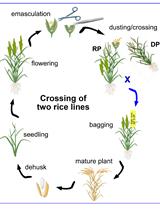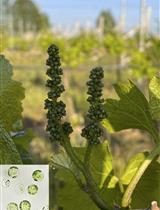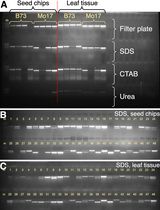- EN - English
- CN - 中文
CRISPR/Cas9-Induced Targeted Mutagenesis of the Moss Physcomitrium patens by Particle Bombardment-Mediated Transformation
利用粒子轰击介导转化的 CRISPR/Cas9 技术在小立碗藓中实现靶向诱导突变
发布: 2025年09月20日第15卷第18期 DOI: 10.21769/BioProtoc.5452 浏览次数: 963
评审: Diarmuid Seosamh Ó’MaoiléidighAnonymous reviewer(s)
Abstract
The clustered regularly interspaced short palindromic repeat (CRISPR)/CRISPR-associated protein 9 (Cas9) system is a widely used programmable nuclease system for gene modification in many organisms, including Physcomitrium patens. P. patens is a model species of moss plants, a basal land plant group, which has been extensively studied from the viewpoint of evolution and diversity of green plant lineages. So far, gene modifications by CRISPR/Cas9 in P. patens have been carried out exclusively by the polyethylene glycol (PEG)-mediated DNA transfer method, in which a transgene (or transgenes) is introduced into protoplast cells prepared from protonemal tissues. However, this PEG-mediated method requires a relatively large amount of transgene DNA (typically 30 µg for a single transformation), consists of many steps, and is time-consuming. Additionally, this PEG-mediated method has only been established in a few species of moss. In the current protocol, we succeeded in CRISPR/Cas9-induced targeted mutagenesis of P. patens genes by making good use of the biolistic method, which i) requires amounts of transgene DNA as low as 5 μg for each vector, ii) consists of fewer steps and is time-saving, and iii) is known to be applicable to a wide variety of species of plants.
Key features
• In this protocol, particle bombardment-mediated gene transfer is used for CRISPR/Cas9-induced mutagenesis in the moss Physcomitrium patens.
• By this application of particle bombardment, a gene can be modified by the CRISPR/Cas9 system much more conveniently with a smaller amount of transgene DNA.
• This protocol is expected to be easily applicable to non-model moss species, some of which have noteworthy traits, such as tolerance to various stresses.
Keywords: Clustered regularly interspaced short palindromic repeat (CRISPR)/CRISPR-associated protein 9 (Cas9) system (CRISPR/Cas9 系统)Background
Physcomitrium patens (Physcomitrella patens) is a model species of moss (Bryopsida) that offers many advantages for experimentation, including applicability of gene targeting based on a highly efficient homologous recombination (HR) [1,2]. Bryopsida is a basal land plant group, phylogenetically positioned between green algae and higher land plant groups [3]. Therefore, P. patens has been extensively studied in the research areas of development, growth, and physiology, largely from the evolutionary point of view [1,4,5]. Gene modification by clustered regularly interspaced short palindromic repeat (CRISPR)/CRISPR-associated protein 9 (Cas9) system was also successfully applied to this moss [6–10], enabling easier disruption of multiple genes and creation of marker-free knockouts and knock-ins, among other advantages. For applying the CRISPR/Cas9 system to P. patens, the polyethylene glycol (PEG)-mediated DNA transfer method has been exclusively used for the introduction of sgRNA and Cas9 expression vectors into cells. However, this PEG-mediated method has the following disadvantages: i) it requires higher amounts of DNA (typically 30 μg per sample) to be introduced into cells; ii) it consists of many steps, including generation of protoplasts from protonema cells, and is time-consuming; iii) sometimes it results in, if at a small ratio, generation of polyploid cells by protoplast fusion [11]. On the other hand, the particle bombardment-mediated DNA transfer into cells requires a much lower amount of DNA (~5 µg for each plasmid) and fewer steps with no need to prepare protoplasts, is time-saving, and involves no cell fusion processes [12,13]. Here, we have established a protocol for modifying P. patens genes using the CRISPR-Cas9 system with particle bombardment-mediated DNA transfer. By using this protocol, the CRISPR/Cas9 system will be more readily applicable not only to P. patens but also to other non-model moss species with interesting traits such as tolerance to various environmental stresses.
Materials and reagents
Biological materials
1. Escherichia coli DH5α (Thermo Fisher Scientific, catalog number: EC0112)
2. Moss [Physcomitrium patens (Physcomitrella patens) ssp. patens] [14] (a kind gift from Dr. Mitsuyasu Hasebe, National Institute for Basic Biology, Okazaki)
Note: The culture methods for P. patens are based on the protocols of PhyscoBase (https://moss.nibb.ac.jp/), developed by Dr. M. Hasebe’s laboratory, with some modifications.
1. Plasmids
a. pSCgRNA (sgRNA expression vector) [7,8]
b. pSCOE1-fcoCas9 (Cas9 nuclease expression vector) [7,8]
2. DNA oligos
a. DNA oligonucleotides for constructing sgRNA vectors (the adapter sequences for cloning in the BbsI-cleaved pSCgRNA are underlined)
i. PPR2_crRNA_Fwd2 (5'-AAACTAGGCAAGTTCGGTCAACTC-3')
ii. PPR2_crRNA_Rv2 (5'-TCTGGAGTTGACCGAACTTGCCTA-3')
iii. PPR38_crRNA_fw2 (5'-TCTGTTAGGAGGTCTAACTACGGG-3')
iv. PPR38_crRNA_rv2 (5'-AAACCCCGTAGTTAGACCTCCTAA-3'
Note: These DNA oligonucleotides were purified by reverse-phase column chromatography and purchased from FASMAC.
3. Primers for genotyping of P. patens clones
a. PpPPR2_cr2_seq_fw (5'-CATCTAGTCGTGCCTCATGAGGA-3')
b. PpPPR2_cr2_seq_rv (5'-TCCATTTGCTGAAGCAAGAGTGG-3')
c. PPR38_cr2_seq_fw2 (5'-GCTGCAATGGAGCCCTGTG-3')
d. PPR38_cr2_seq_rv2 (5'-CGTCGCTTGAACAATGGTGAAGG-3')
Reagents
1. 1.0 μm gold microcarriers (Bio-Rad, catalog number: 1652263)
2. 99.5% ethanol (FUJIFILM Wako Pure Chemical Corporation, catalog number: 057-00456)
3. Glycerol (FUJIFILM Wako Pure Chemical Corporation, catalog number: 075-00616)
4. Spermidine (FUJIFILM Wako Pure Chemical Corporation, catalog number:191-13831)
5. Agar (Sigma, catalog number: A6924)
6. Agar (FUJIFILM Wako Pure Chemical Corporation, catalog number: 016-11875)
Note: Use agar from Sigma and FUJIFILM Wako Pure Chemical for culturing moss and E. coli cells, respectively.
7. G418 (G418 sulfate, also known as geneticin) (FUJIFILM Wako Pure Chemical Corporation, catalog number: 078-05961)
8. D-Glucose (FUJIFILM Wako Pure Chemical Corporation, catalog number: 049-31165)
9. MgSO4·7H2O (FUJIFILM Wako Pure Chemical Corporation, catalog number: 131-00405)
10. MgCl2·6H2O (FUJIFILM Wako Pure Chemical Corporation, catalog number: 135-00165)
11. KH2PO4 (FUJIFILM Wako Pure Chemical Corporation, catalog number: 169-04245)
12. KNO3 (FUJIFILM Wako Pure Chemical Corporation, catalog number: 160-04035)
13. FeSO4·7H2O (FUJIFILM Wako Pure Chemical Corporation, catalog number: 098-01085)
14. CuSO4·5H2O (FUJIFILM Wako Pure Chemical Corporation, catalog number: 039-04412)
15. H3BO3 (FUJIFILM Wako Pure Chemical Corporation, catalog number: 027-02192)
16. CoCl2·6H2O (FUJIFILM Wako Pure Chemical Corporation, catalog number: 036-03682)
17. Na2MoO4·2H2O (FUJIFILM Wako Pure Chemical Corporation, catalog number: 196-02472)
18. ZnSO4·7H2O (FUJIFILM Wako Pure Chemical Corporation, catalog number: 264-00402)
19. MnCl2·4H2O (FUJIFILM Wako Pure Chemical Corporation, catalog number: 139-00722)
20. KI (FUJIFILM Wako Pure Chemical Corporation, catalog number: 164-03972)
21. NaCl (FUJIFILM Wako Pure Chemical Corporation, catalog number: 191-01665)
22. Ammonium tartrate (FUJIFILM Wako Pure Chemical Corporation, catalog number: 195042)
23. CaCl2·2H2O (FUJIFILM Wako Pure Chemical Corporation, catalog number: 033-25035)
24. 2-amino-2-hydroxymethyl-1,3-propanediol (FUJIFILM Wako Pure Chemical Corporation, catalog number: 011-20095)
25. Bacto tryptone (ThermoFisher Scientific, catalog number: 211705)
26. Bacto yeast extract (ThermoFisher Scientific, catalog number: 212750)
27. T4 polynucleotide kinase (Takara Bio, catalog number: 2021S)
28. T4 DNA ligase (Nippon Gene, catalog number: 311-00404)
29. BpiI (BbsI) (ThermoFisher Scientific, catalog number: ER1011)
30. NucleoSpin Gel and PCR Clean-Up kit (Macherey-Nagel, catalog number: 740609.50)
31. BigDye Terminator v3.1 Cycle Sequencing kit (ThermoFisher Scientific, catalog number: 4337455)
32. SupreDye Cycle Sequencing kit v3.1 (M&S TechnoSystems, catalog number: 063002)
33. NucleoBond Xtra Midi kit (Macherey-Nagel, catalog number: 740410.50)
Solutions
1. Stock solutions for culture media: Stock solution B (×100), stock solution C (×100), stock solution D (×100), and alternative TES solution (×1000) (see Recipes)
2. Culture media for moss: BCDG agar medium, BCDAT agar medium, BCDATG agar medium, and BCDATG (G418+) agar medium (see Recipes)
3. Culture media for E. coli: LB liquid medium and LB agar plates (see Recipes)
4. Chemicals: 500 mM ammonium tartrate solution, 50 mM CaCl2 solution, 50% (v/v) glycerol solution, 1.0 M Tris-HCl (pH 7.4), and 1.0 M MgCl2 (see Recipes)
5. Reaction buffer (5× annealing buffer) (see Recipes)
Recipes
1. Stock solutions for culture media
Notes: These stock solutions and culture media for the growth of P. patens are based on the above-mentioned PhyscoBase. In the PhyscoBase protocols, there is also “stock solution A,” which is used for the PEG-mediated transformation method.
Stock solution B (100×): 25 g/L MgSO4·7H2O
Stock solution C (100×): 25 g/L KH2PO4 (pH adjusted to 6.5 with 4 M KOH)
Stock solution D (100×): 101 g/L KNO3, 1.25 g/L FeSO4·7H2O
Alternative TES solution (1,000×): 55 mg/L CuSO4·5H2O, 614 mg/L H3BO3, 55 mg/L CoCl2·6H2O, 25 mg/L Na2MoO4·2H2O, 55 mg/L ZnSO4·7H2O, 389 mg/L MnCl2·4H2O, 28 mg/L KI
2. Culture media for moss
BCDG agar medium: 900 mL of purified water, 10 mL of stock solution B, 10 mL of stock solution C, 10 mL of stock solution D, 1 mL of alternative TES solution, 20 mL of 50 mM CaCl2 solution, 10 g of D-Glucose, and 8 g of agar. Fill up to 1,000 mL with water. Autoclave at 121 °C for 20 min and pour into 9.0-cm diameter plastic plates to solidify.
BCDAT agar medium: 900 mL of purified water, 10 mL of stock solution B, 10 mL of stock solution C, 10 mL of stock solution D, 1 mL of alternative TES solution, 20 mL of 50 mM CaCl2 solution, 10 mL of ammonium tartrate solution (500 mM), and 8 g of agar. Fill up to 1,000 mL with water. Autoclave at 121 °C for 20 min and pour into 9.0-cm diameter plastic plates to solidify.
BCDATG agar medium: 10 g/L D-Glucose supplemented to the BCDAT agar medium.
BCDATG (G418+) agar medium: G418 (20 mg/L) supplemented to the BCDATG agar medium.
Note: Use 10 g/L instead of 5 g/L of D-glucose in the original protocol in PhyscoBase.
3. Culture media for E. coli
LB liquid medium: 900 mL of purified water, 10 g of Bacto tryptone, 5 g of Bacto yeast extract, and 10 g of NaCl. Fill up to 1,000 mL with purified water and autoclave at 121 °C for 20 min.
LB agar plates: Supplement LB liquid medium with 12 g of agar (before autoclaving); then, autoclave at 121 °C for 20 min and pour into 9.0-cm diameter plastic plates to solidify.
Note: For agar, use the Sigma and FUJIFILM Wako Pure Chemical products for culturing moss and E. coli cells, respectively.
4. Chemicals
500 mM ammonium tartrate solution: 92.05 g/L ammonium tartrate.
50 mM CaCl2 solution: 7.35 g/L CaCl2.
50% (v/v) glycerol solution: mix equal volumes of sterile purified water and glycerol.
1.0 M Tris-HCl (pH 7.4): 121.1 g/L 2-amino-2-hydroxymethyl-1,3-propanediol; adjust pH to 7.4 with HCl.
1.0 M MgCl2: 203.3 g/L MgCl2·6H2O.
5. Reaction buffer (5× annealing buffer)
50 mL of 1.0 M Tris-HCl (pH 7.4), 35 mL of 1.0 M MgCl2, and 15 mL of purified water.
Laboratory supplies
1. Petri dishes (90 mm × 15 mm) (Rikaken Holdings, catalog number: LT-DS-9015)
2. 1.5 mL microtubes (Watson, catalog number: 131-815C)
3. 0.2 mL 8-strip PCR tubes (SSIbio, catalog number: 3240-00)
4. 15 mL plastic pipette (As One, catalog number: 1-2247-14)
5. Cellophane sheets (Futamura Chemical, catalog number: PL300)
6. 10 μL plastic pipette tips (BMBio, catalog number: 104-Q)
7. 200 μL plastic pipette tips (Watson, catalog number: 110-705C)
8. 1,000 μL plastic pipette tips (Watson, catalog number: 110-706C)
9. Micropore surgical tape (3M, catalog number: 1530-0)
10. Fluorescent lamps (TOSHIBA LIGHTING & TECHNOLOGY CORPORATION, catalog number: FL20SS W/18)
Equipment
1. Plant growth chamber (SANYO, catalog number: MLR-350)
2. Micropipettes (GILSON, catalog number: P2L, P20L, P200L, P1000L)
3. Tweezers (KOWA Forceps Industry, catalog number: K-17)
4. High-speed refrigerated micro-centrifuges (TOMY SEIKO, catalog number: MX-107)
5. Clean bench (Nippon Medical & Chemical Instruments, catalog number: VSF-850A)
6. Thermal cycler (TAKARA Bio, catalog number: TP-600)
7. Block incubator (ASTEC, catalog number: BI-515)
8. Autoclave (TOMY SEIKO, catalog number: BS-245)
9. Agarose gel electrophoresis tanks (TAKARA Bio, catalog number: M-2P)
10. Ultraviolet transilluminator (ATTO, catalog number: AE-6932)
11. Particle delivery system (Tanaka, catalog number: GIE-III)
12. Homogenizer (Microtec nition, catalog number: NS-310E)
Software and datasets
1. SnapGene version 5.1.7 (released July 20, 2020; a subscription license is required to use this software)
2. CRISPR-P 2.0 (released October 2016; http://crispr.hzau.edu.cn/CRISPR2/) [15]
3. CRISPRdirect version 140413 (https://crispr.dbcls.jp/) [16]
4. PPR version 6719c98 (https://ppr.plantenergy.uwa.edu.au/) [17]
Procedure
文章信息
稿件历史记录
提交日期: Jun 23, 2025
接收日期: Aug 15, 2025
在线发布日期: Sep 2, 2025
出版日期: Sep 20, 2025
版权信息
© 2025 The Author(s); This is an open access article under the CC BY-NC license (https://creativecommons.org/licenses/by-nc/4.0/).
如何引用
Takenaka, S., Sugita, M., Nomura, T. and Aoki, S. (2025). CRISPR/Cas9-Induced Targeted Mutagenesis of the Moss Physcomitrium patens by Particle Bombardment-Mediated Transformation. Bio-protocol 15(18): e5452. DOI: 10.21769/BioProtoc.5452.
分类
植物科学 > 植物分子生物学 > 遗传分析
分子生物学 > DNA > 诱/突变
生物科学 > 生物技术 > CRISPR/Cas9
您对这篇实验方法有问题吗?
在此处发布您的问题,我们将邀请本文作者来回答。同时,我们会将您的问题发布到Bio-protocol Exchange,以便寻求社区成员的帮助。
Share
Bluesky
X
Copy link











